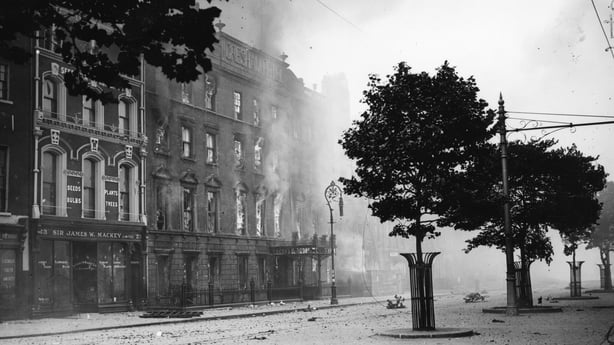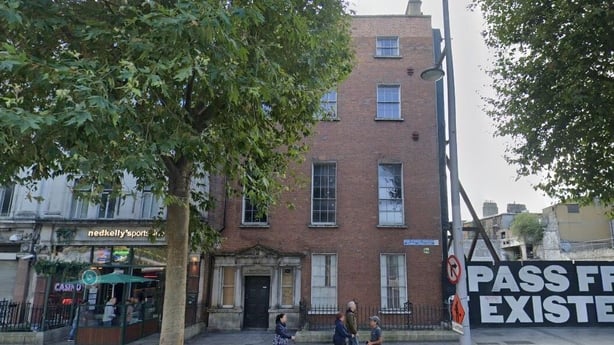Opinion: 42 Upper O'Connell Street is the last house standing from the original 1750s development, a unique and culturally irreplaceable structure
An Bord Pleanála has granted permission for the contested development between Dublin's Moore Street and O'Connell Street to proceed. The controversy centres on the development of the houses surrounding the national monument to the 1916 Rising at 14-17 Moore Street. It was appealed by a number of groups, including the Moore Street Preservation Trust and the 1916 Rising Relatives Association, local businesses and Sinn Féin leader Mary Lou McDonald.
The greater part of the scheme centres on the protracted and much needed development of the eastern side of Upper O’Connell Street: in essence, the regeneration and restoration of nos 39 - 59.
This block of the capital’s main street has suffered decades of maladministration and neglect, with empty plots now glaring gaps in the streetscape. Many other surviving buildings host fast food restaurants, retail and gambling casinos. It is impossible to imagine the culturally significant principal high streets of other European capitals suffering such a fate.
Amidst all this, stands the last remaining Georgian house on O'Connell street: No 42.
We need your consent to load this rte-player contentWe use rte-player to manage extra content that can set cookies on your device and collect data about your activity. Please review their details and accept them to load the content.Manage Preferences
From RTÉ Archives, An RTÉ News report from 1974 on plans to redevelop Moore Street, with Toal Ó Muiré from the UCD school of Architecture
Laid out as an audacious property development in the mid-eighteenth century by the rich and powerful Luke Gardiner and Associates, the grand urban mansions built on the street housed the gentry, aristocracy and the cream of Dublin society. It was home to at least 28 MPs, housed earls, barons, viscounts and lords of the realm, and was well stocked with the abodes of barristers, attorneys and solicitors. There were also many high-ranking military officers and clergy, bankers, professors, doctors and members of local government on the street.
The width of Sackville Street (later O'Connell), which it retains, was dictated by the addition of a rectangular walled Mall surrounded by large obelisks with lamps, and allowed its wealthy residents to play Pall Mall (croquet) or to strut in their finery. This was rather fleeting, however. By 1787, the Mall was gone, and the street was slowly and steadily commercialised, both before and particularly after the extension of the thoroughfare to the River Liffey around 1790-1820.
Entering a new phase, the street became the heart of a new city centre and the dominant commercial area within the capital. Yet, this was a tale of two different streets. The lower end featured intentional shop-houses suited medium-sized retail, such as jewellers and drapers. The older, upper end, however, featured grand mansions, and played host to far loftier ventures. These included luxurious hotels; fencing, opera, dancing and language schools; ballrooms; auction houses and art galleries. Some houses were altered and amalgamated in the nineteenth century. Prime examples of these were the Gresham Hotel, which was at 21/22 Upper Sackville Street, and the later Hammam Hotel at Nos 11-13 on the same side of the street.

But the twentieth century proved to be very unkind to O'Connell Street. Most of the upper eastern side, and some of the western side, was destroyed in the civil war in July 1922. While the majority of the rest of the surviving western side was demolished in various ill-thought-out ventures between the 1930s and 1970s. One significant example was the demolition of the 200-year-old former home of the Sackville Street Club, at 59 Upper Sackville Street, to make way for CIÉ/Dublin Bus in 1959.
One by one, the Georgian houses vanished and only a small number survive as commercial conversions. This is why no 42 Upper O’Connell Street is so significant. It is the last house standing from the original 1750s development and for this reason is unique and culturally irreplaceable.
The history of 42 Upper O'Connell Street
State Physician and Professor of Anatomy in Trinity College Robert Robinson built no 42, obtaining the lease from Luke Gardiner in February 1752. It was listed as a superior four-storey building with extensive cellars, rear and offices attached. The design was by the eminent architect Richard Castle (sometimes Castles, Cassels, Cassells), who was employed as a draughtsman on the construction of Parliament House (Bank of Ireland) College Green. The construction of No 42 was supervised by John Ensor, Castle’s clerk. The plasterwork may have been the hand of stuccodore Robert West.
We need your consent to load this rte-player contentWe use rte-player to manage extra content that can set cookies on your device and collect data about your activity. Please review their details and accept them to load the content.Manage Preferences
From RTÉ Archives, Architect and historian Sean Rothery takes a walk down Dublin's O'Connell Street and highlights 42 O'Connell Street
Sir Archibald Acheson later took over the lease and passed it to his grandson Viscount Gosford, after which it was then sublet to Robert Hamilton, an attorney, in 1808. At the same time, it was also the premises of a tailor by the name of Dunn in 1803. No 42 was advertised for sale in 1817 and was the home of a Mr Harper in 1819. In 1825 it shared an address with a Viennese music school under the tutorship of a Professor Schulz. The house was home to the wine merchants French, Sneyd and Barton in the 1820s and 1830s. The premises later became the offices of the Royal Agricultural Improvement Society and Irish Farmers’ Club, before becoming the offices of the Catholic Commercial Club and it served in this capacity until the 1970s.
During the Irish civil war, the building was occupied by the anti-treaty IRA who withdrew under assault from the National army in July 1922, who then subsequently occupied it themselves. As a result, No 42 suffered significant damage. The roof, windows and electrical fittings had to be replaced, while some private items were looted. A claim for compensation from the Irish government led to an award of £436 for property damages and loss.
The building has now been vacant since the 1980s. Labelled 'O’Connell Hall’, and once - perhaps still - complete with a seated theatre, billiards room, bar and library, the building survives as the last Georgian house on the street, largely because it has avoided conversion for retail or hospitality over 270 years.

But what happens now? No 42 is slated for restoration as part of the new development. However, a platinum opportunity could be missed here in failing to turn this unique building into a time capsule museum, which could explore and detail the former residential and commercial glory of this important street.
This is a move which has been implemented successfully in relation to Luke Gardiner's other residential venture on Henrietta Street. As a result, the 14 Henrietta Street enjoys a crucial role in bringing cultural footfall, ensuring the legacy of the street.
Read more: How problems facing Dublin's O'Connell Street are a legacy of the past
This is common in cities elsewhere. There are over 21 house museums in London alone, including the Georgian houses of Dr Johnson, Dennis Sever and the Handel and Hendrix house. These rich cultural monuments are vital to directing curiosity onto an urban street, where they can act as time portals, immersing the visitor in displays, talks and even interactive activities in relation to the past. Such a culturally immersive experience of our residential and commercial 18th and 19th century history is much needed on the main street of our capital.
If the Irish government and the city’s municipal authorities are serious about a cultural revival of O’Connell Street, then they need to invest in such cultural attractions. Retail and hotels alone will not suffice. The next time you pass this jewel on O’Connell Street, stop: take in the building and imagine the history engrained within its walls. Then ask, what is to become of this under-appreciated national treasure?
Follow RTÉ Brainstorm on WhatsApp and Instagram for more stories and updates
The views expressed here are those of the author and do not represent or reflect the views of RTÉ







